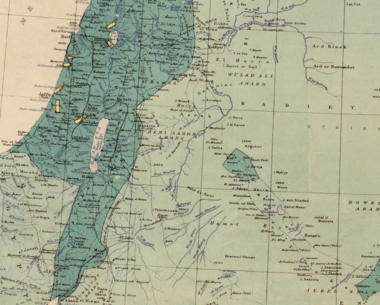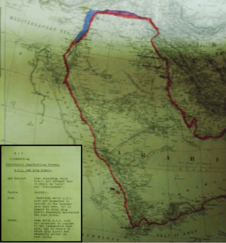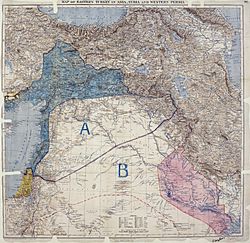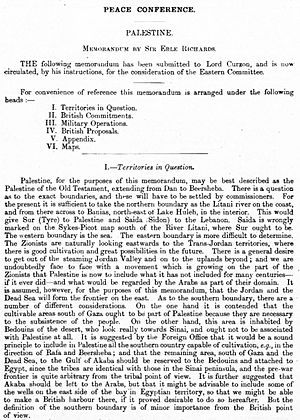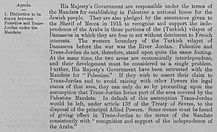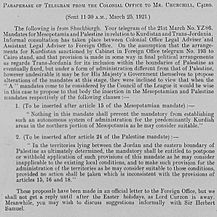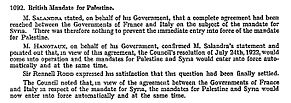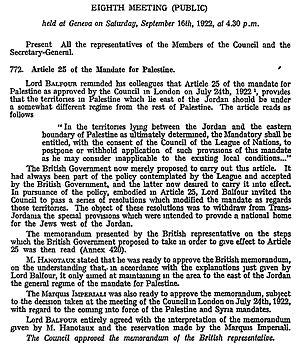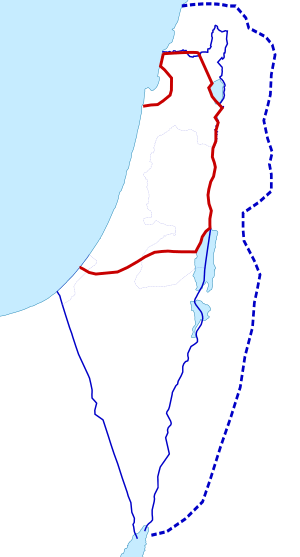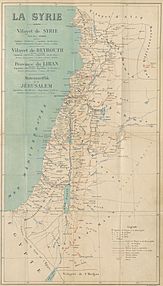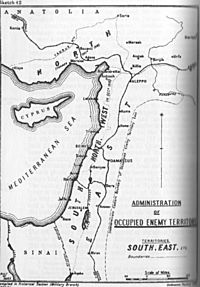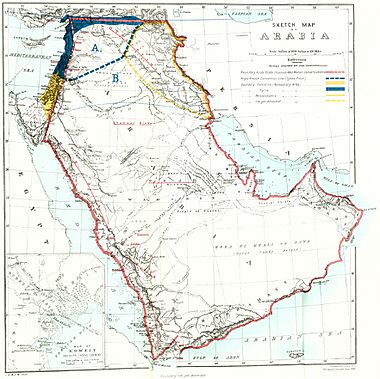Mandate for Palestine facts for kids
Quick facts for kids League of Nations – Mandate for Palestine and Transjordan Memorandum |
|
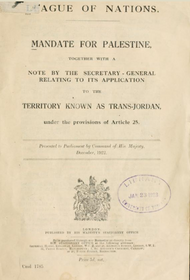 British Command Paper 1785, December 1922, containing the Mandate for Palestine and the Transjordan memorandum
|
|
| Created | Mid-1919 – 22 July 1922 |
| Location | UNOG Library; ref.: C.529. M.314. 1922. VI. |
| Signers | Council of the League of Nations |
| Purpose | Creation of the territories of Mandatory Palestine and the Emirate of Transjordan |
The Mandate for Palestine was like a special agreement. It gave Britain the job of managing the areas known as Palestine and Transjordan. These lands used to be part of the Ottoman Empire. The Ottoman Empire lost them after World War I ended in 1918.
The League of Nations, an international group, gave this job to Britain. This happened at a meeting in San Remo in April 1920. Britain started managing Palestine in July 1920 and Transjordan in April 1921. The Mandate was officially in place from September 29, 1923, until May 15, 1948, for Palestine. Transjordan became independent earlier, on May 25, 1946.
The main goal of these mandates was to help these former Ottoman lands. The idea was to give them "administrative advice and assistance" until they could rule themselves. The borders between Palestine and Transjordan were set in the final agreement. The northern border with French-controlled Syria and Lebanon was also agreed upon.
In Palestine, Britain had to follow the Balfour Declaration. This declaration supported creating a "national home for the Jewish people." This was alongside the Palestinian Arabs, who were the majority living there. However, this rule did not apply to Transjordan. Britain managed Palestine for nearly 30 years. During this time, there were many protests and conflicts between Jewish and Palestinian Arab groups.
Two nationalist movements grew during the Mandate period. These were among the Jewish people and the Palestinian Arabs. Conflicts eventually led to major revolts. The United Nations Partition Plan for Palestine was approved in November 1947. This plan suggested creating separate Jewish and Arab states. It also proposed that Jerusalem be managed by the UN.
Britain announced the Mandate would end on May 15, 1948. On that day, the Jewish community declared the State of Israel. After the UN plan failed, the 1947–1949 Palestine war broke out. Mandatory Palestine was then divided among Israel, the West Bank (controlled by Jordan), and the Gaza Strip (controlled by Egypt).
Transjordan was added to the Mandate after a meeting in Cairo in March 1921. It was decided that Abdullah bin Hussein would rule Transjordan. He would do so under Britain's guidance. Transjordan became more self-governing over time. It gained full independence with a treaty in March 1946.
Contents
Why Was the Mandate Created?
The Mandate for Palestine was created after World War I. It was part of a bigger plan to reorganize lands that used to belong to the Ottoman Empire. Many agreements and promises were made during and after the war.
Promises to Different Groups
During World War I, Britain made several promises. These promises sometimes conflicted with each other.
The Balfour Declaration: A Jewish National Home
In November 1914, Britain declared war on the Ottoman Empire. Soon after, British leaders started thinking about the future of Palestine. At that time, Palestine had a small Jewish population.
On November 2, 1917, Britain issued the Balfour Declaration. This public statement supported creating a "national home for the Jewish people" in Palestine. This was the first time a major world power publicly supported Zionism. Zionism is the movement for Jewish self-determination.
The term "national home" was new in international law. It was not clear if it meant a Jewish state. The declaration also said that nothing should harm the rights of the non-Jewish people living in Palestine. It also protected the rights of Jewish communities in other countries. The Balfour Declaration was later included in the Mandate for Palestine. This made it a legally binding promise for Britain.
Promises to Arabs: Independence
Between 1915 and 1916, letters were exchanged. These were between Sharif Hussein bin Ali, an Arab leader, and Sir Henry McMahon, a British official. In these letters, Britain agreed to support Arab independence after the war. In return, Sharif Hussein would lead an Arab Revolt against the Ottoman Empire.
The area for Arab independence was generally defined. However, there were disagreements about whether Palestine was included. At the Paris Peace Conference in 1919, British Prime Minister David Lloyd George said these letters were a treaty.
Secret Agreement with France: Sykes–Picot
Around the same time, Britain and France made a secret agreement. This was called the Sykes–Picot Agreement. It decided how they would divide the Ottoman Empire's lands. This agreement was made in 1916.
It gave Britain control over parts of present-day southern Israel, Palestine, Jordan, and southern Iraq. France would control Syria and Lebanon. The Palestine region was supposed to be under "international administration."
The League of Nations and Mandates
The mandate system was created after World War I. It was a way to manage former colonies and territories. The idea was to help these areas become independent. This system was part of the Covenant of the League of Nations. This was a key part of the Treaty of Versailles, signed in 1919.
The main ideas behind the mandate system were:
- The powerful country would not take the territory for itself.
- It would manage the territory as a "sacred trust." This meant developing the area for the benefit of its local people.
Unlike older systems, the League of Nations supervised the mandatory power. This ensured the country in charge met its duties to the people.
How Britain Got the Mandate
Britain was chosen to manage Palestine and Transjordan. This decision came after many discussions.
Palestine's Assignment
Discussions about who would control the region started right after the war. They continued at the Paris Peace Conference. Finally, at the San Remo conference in April 1920, the decision was made. The Allied Supreme Council gave Britain the mandates for Palestine and Mesopotamia (modern-day Iraq). France received the mandates for Syria and Lebanon.
Arab leaders, like Emir Faisal, wanted Palestine to be part of a larger Arab state. They later suggested an Arab state under British control. The World Zionist Organization, led by Chaim Weizmann, also asked for a British mandate. They emphasized the Jewish people's historical connection to Palestine.
In December 1918, France secretly agreed to give Palestine to Britain. This was an update to the Sykes–Picot Agreement. This was confirmed at the San Remo conference. The Mandate for Palestine was formally given to the United Kingdom.
Adding Transjordan
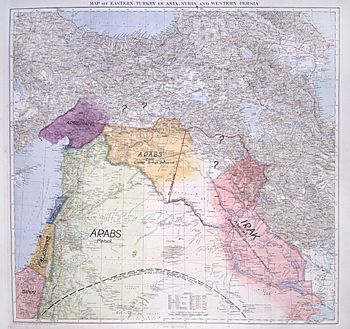
Under earlier agreements, Transjordan was meant to be part of an independent Arab state. British forces had even pulled back from Transjordan in 1918. This showed they thought it would be part of an Arab Syrian state.
Transjordan was not mentioned when the Mandate for Palestine was first given in 1920. Britain and France agreed the Jordan River would be Palestine's eastern border. Britain decided that the Palestine government would not extend east of the Jordan River. They also believed Transjordan should be part of the "Arab independence" area.
After France defeated the Arab Kingdom of Syria in July 1920, Transjordan became a "no-man's land." British Foreign Minister Lord Curzon decided Transjordan should be independent but closely linked to Palestine.
In November 1920, Abdullah, brother of the deposed King Faisal, marched into Transjordan. His army took control of the area with local support.
The Cairo Conference was held in March 1921. Winston Churchill, Britain's Colonial Secretary, led it. The goal was to add Transjordan to the Palestine mandate. Abdullah would be the emir (prince) of Transjordan. The important condition was that the Jewish National Home rules would not apply there. This was made legal by adding Article 25 to the Palestine Mandate.
Developing the Mandate Document
The Mandate document went through many changes. Different groups had different ideas for its rules.
Early Discussions and Changes
Drafting the Palestine Mandate began before it was officially given to Britain. Early drafts were discussed between British officials and Zionist leaders. By December 1919, a "compromise" draft was created.
However, Lord Curzon, who took over from Balfour, was critical. He felt the draft "forgot" the Arabs. He insisted on changes to remove phrases that suggested legal rights for a Jewish state. For example, "self-governing Commonwealth" was changed to "self-governing institutions."
After strong objections, the statement about the historical connection of Jews to Palestine was put back. The draft was sent to the League of Nations in December 1920.
Adding the Transjordan Article
The addition of Article 25 was approved in March 1921. This article allowed Britain to "postpone or withhold application" of parts of the mandate. This was for areas where conditions made it unsuitable. This meant Britain could set up an Arab government in Transjordan. It also meant the Jewish National Home rules would not apply there.
This created two separate areas. Palestine would be under direct British rule. Transjordan would be an autonomous emirate under the Hashemite family. Churchill confirmed this to Abdullah in March 1921. He said Transjordan would not be part of the Jewish national home.
Palestinian Arab Involvement
|
A New York Times report from 1921 about the Syrian–Palestinian Congress.
|
The Mandate was drafted without input from Arab leaders. Palestinian groups, like the Palestine Arab Congress, tried to share their views. They sent delegations to Cairo, Jerusalem, and London. They asked for the Balfour Declaration to be reconsidered. They also wanted an end to Jewish immigration. All their demands were rejected.
A delegation also went to the Lausanne Conference in 1922. They hoped to get the Balfour Declaration removed from the new treaty with Turkey. However, Turkey's lead negotiator avoided helping them. The mandates were not mentioned in the final treaty, but this did not stop their implementation.
Approving the Mandate
The Mandate needed approval from various groups.
British Parliament's Role
British public opinion became less supportive of Zionism. In February 1922, Churchill noted growing opposition in Parliament. He said it was hard to justify the cost to British taxpayers.
The House of Lords rejected the Palestine Mandate in June 1922. However, the House of Commons later overruled this vote. In 1923, a secret review of Palestine policy began. It questioned if Britain should stay in Palestine and continue its pro-Zionist policy. The Cabinet decided it was too difficult to change course.
United States' Involvement
The United States was not a member of the League of Nations. However, it asked to comment on the draft mandate. In May 1922, the U.S. and UK agreed that the U.S. had to approve any changes to the mandate. In September 1922, the U.S. Congress endorsed the Balfour Declaration. In 1924, the U.S. signed a treaty with Britain. This treaty agreed to Britain's administration of Palestine.
League of Nations Council Approval
The Council of the League of Nations met in July 1922. They approved the mandates for Palestine and Syria. The Palestine mandate was approved on July 22, 1922. This gave Britain formal international recognition for its control. The mandates officially came into effect on September 29, 1923.
Transjordan Memorandum Approval
In September 1922, the League of Nations approved a British memorandum. This document explained how Article 25 would be used. It formally excluded Transjordan from the rules about Jewish settlement. Lord Balfour explained that this was always part of the plan. It meant that the special rules for a Jewish national home would not apply east of the Jordan River.
Turkey's Recognition
Turkey was not part of the League of Nations at first. As a losing side in World War I, decisions about Ottoman territory were in the Treaty of Sèvres (1920). However, this treaty was never fully accepted by Turkey.
A new treaty, the Treaty of Lausanne, was signed in July 1923. In this treaty, Turkey officially gave up its claim to Palestine. This helped clear the way for the mandates to take full effect.
Key Aspects of the Mandate
The Mandate document had several important sections.
National Home for the Jewish People
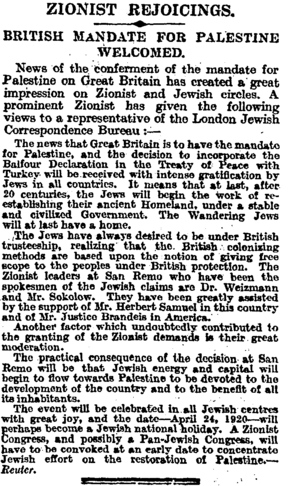
The Mandate's introduction stated that Britain was responsible for putting the Balfour Declaration into effect. This meant helping to establish a "national home for the Jewish people" in Palestine. It also clearly stated that this should not harm the rights of non-Jewish people.
The Mandate also recognized the "historical connection of the Jewish people with Palestine." Article 4 of the Mandate recognized the Jewish Agency. This group would advise and work with the British administration. It would help with economic and social matters related to the Jewish National Home. Article 7 also said that a nationality law would make it easier for Jews to become Palestinian citizens.
Religious and Community Issues
The Mandate included rules for religious freedom. It ensured that all forms of worship were allowed. Article 15 stated that no one should be discriminated against based on race, religion, or language. It also said no one should be kept out of Palestine just because of their religious beliefs.
Britain was responsible for the Holy Places under Article 13. Article 14 called for a commission to define rights related to religious communities. However, this commission was never fully set up.
Transjordan's Special Status
Article 25 of the Mandate and the Transjordan memorandum clarified Transjordan's special status. This led some to mistakenly believe that Transjordan was initially part of the Jewish National Home area. However, it was always intended to be separate.
In April 1923, Britain announced it would recognize an "independent Government" in Transjordan. This government would be under Amir Abdullah. This meant Transjordan would be an Arab country, separate from Palestine. The Zionist clauses of the Mandate would not apply there.
Borders of the Mandate
Before World War I, Palestine and Transjordan were parts of the Ottoman Empire. After the war, British military administrations divided the territory. Palestine was in the south, and Transjordan was in the east.
Southern Border with Egypt
The border with British-ruled Egypt was agreed upon early. It followed the existing border from 1906. The Negev region was added to Palestine in July 1922. This gave Palestine access to the Red Sea.
Northern Borders with Syria and Lebanon
The northern border was more complex. It separated British and French controlled areas. This border was defined by the Franco-British Boundary Agreement of December 1920. This agreement is known as the Paulet–Newcombe Agreement. It placed most of the Golan Heights in the French area. The Zionist movement pushed for Palestine to include many water sources. This led to the inclusion of the Sea of Galilee and parts of the Jordan River.
Border Between Palestine and Transjordan
Transjordan was part of the Arab administration after the war. Britain was fine with this because it was an ally. The Jordan River was chosen as the border between Palestine and Transjordan. This was written in Article 25 of the Mandate. The detailed boundary was officially stated in September 1922.
Southern Border with Arabia
The southern border between Transjordan and Arabia was important. It gave Transjordan access to the sea through the Port of Aqaba. The Ma'an-Aqaba region was claimed by both Transjordan and the Kingdom of Hejaz. After a conflict in 1924–25, this region was formally added to Transjordan.
End of the Mandate
Mandatory Palestine's End
Britain controlled Palestine for almost 30 years. This period saw many protests and revolts. The United Nations Partition Plan for Palestine was passed in November 1947. It proposed separate Jewish and Arab states.
Britain announced the Mandate would end on May 15, 1948. On that day, the State of Israel was created. This led to the 1948 Arab–Israeli War. Mandatory Palestine was then divided among Israel, Jordan, and Egypt.
Transjordan's Independence
In April 1923, Britain announced it would recognize an "independent Government" in Transjordan. Transjordan became largely self-governing by 1928. It gained full independence with a treaty with Britain on March 22, 1946.
Key Dates: From Balfour Declaration to Mandate
| Administration | |||||
|---|---|---|---|---|---|
| Year | Date | Document | Palestine | Transjordan | |
| Before the war | Ottoman sanjaks: Jerusalem, Nablus and Acre | Ottoman sanjaks: Hauran and Ma'an | |||
| 1915 | 24 October | McMahon–Hussein Correspondence | |||
| 1916 | 3 January | Sykes–Picot Agreement | |||
| 1917 | 2 November | Balfour Declaration | |||
| 1918 | 23 October | OETA South under British rule | OETA East under Arab-British rule | ||
| 1 December | France gives up claim over Palestine | ||||
| 1919 | 28 June | Covenant of the League of Nations signed | |||
| 1920 | 10 January | Covenant of League of Nations begins | |||
| 8 March | Kingdom of Syria declared | ||||
| 25 April | Mandate assigned at San Remo | ||||
| 1 July | Civil administration begins | ||||
| 23 July | Becomes a no-man's land after battle | ||||
| 10 August | Treaty of Sèvres signed (never ratified) | ||||
| 11–26 August | Curzon policy: no British administration in the area | ||||
| 21 November | Abdullah's army moves into southern Transjordan | ||||
| 7 December | First draft sent to League of Nations | ||||
| 23 December | Agreement on northern boundary | ||||
| 1921 | 12–30 March | Cairo conference. Article 25 drafted | Proposal to add to Palestine mandate, as separate Arab entity | ||
| 11 April | Emirate of Transjordan established | ||||
| 1922 | 24 July | Mandate terms approved | |||
| 10 August | Palestine constitution signed | ||||
| 16 September | Transjordan memorandum accepted | ||||
| 23 October | 1922 census of Palestine | ||||
| 1923 | 25 April | Independence announcement | |||
| 29 September | Mandate comes into effect | ||||
See also
- Permanent Mandates Commission


